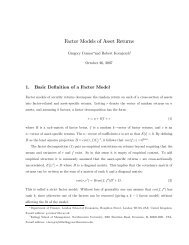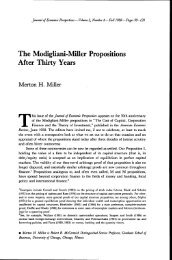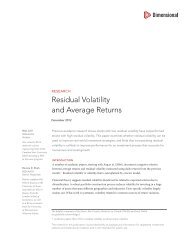Campbell, John Y, Jens Hilscher and Jan Szilagyi, 2005.
Campbell, John Y, Jens Hilscher and Jan Szilagyi, 2005.
Campbell, John Y, Jens Hilscher and Jan Szilagyi, 2005.
You also want an ePaper? Increase the reach of your titles
YUMPU automatically turns print PDFs into web optimized ePapers that Google loves.
5 ConclusionThis paper makes two main contributions to the literature on financial distress. First,we carefully implement a reduced-form econometric model to predict corporate bankruptcies<strong>and</strong> failures at short <strong>and</strong> long horizons. Our best model has greater explanatorypower than the existing state-of-the-art models estimated by Shumway (2001)<strong>and</strong> Chava <strong>and</strong> Jarrow (2004), <strong>and</strong> includes additional variables with sensible economicmotivation. We believe that models of the sort estimated here have meaningfulempirical advantages over the bankruptcy risk scores proposed by Altman (1968) <strong>and</strong>Ohlson (1980). While Altman’s Z-score <strong>and</strong> Ohlson’s O-score were seminal earlycontributions, better measures of bankruptcy risk are available today. We have alsopresented evidence that failure risk cannot be adequately summarized by a measure ofdistance to default inspired by Merton’s (1974) pioneering structural model. Whileour distance to default measure is not exactly the same as those used by Crosbie<strong>and</strong> Bohn (2001) <strong>and</strong> Vassalou <strong>and</strong> Xing (2004), we believe that this result, similar tothat reported independently by Bharath <strong>and</strong> Shumway (2004), is robust to alternativemeasures of distance to default.Second, we show that stocks with a high risk of failure tend to deliver anomalouslylow average returns. We sort stocks by our 12-month-ahead estimate of failure risk,calculated from a model that uses only historically available data at each point intime. We calculate returns <strong>and</strong> risks on portfolios sorted by failure risk over theperiod 1981-2003. Distressed portfolios have low average returns, but high st<strong>and</strong>arddeviations, market betas, <strong>and</strong> loadings on Fama <strong>and</strong> French’s (1993) small-cap <strong>and</strong>value risk factors. Thus, from the perspective of any of the leading empirical assetpricing models, these stocks have negative alphas. This result is a significant challengeto the conjecture that the value <strong>and</strong> size effectsareproxiesforafinancial distresspremium. More generally, it is a challenge to st<strong>and</strong>ard models of rational asset pricingin which the structure of the economy is stable <strong>and</strong> well understood by investors.Some previous authors have reported evidence that distressed stocks underperformthemarket,butresultshavevariedwiththemeasureoffinancialdistress thatis used. Our results are consistent with the findings of Dichev (1998), who usesAltman’s Z-score <strong>and</strong> Ohlson’s O-score to measure financial distress, <strong>and</strong> Garlappi,Shu, <strong>and</strong> Yan (2005), who obtain default risk measures from Moody’s KMV. Vassalou<strong>and</strong> Xing (2004) calculate distance to default; they find some evidence thatdistressed stocks with a low distance to default have higher returns, but this evidence23





